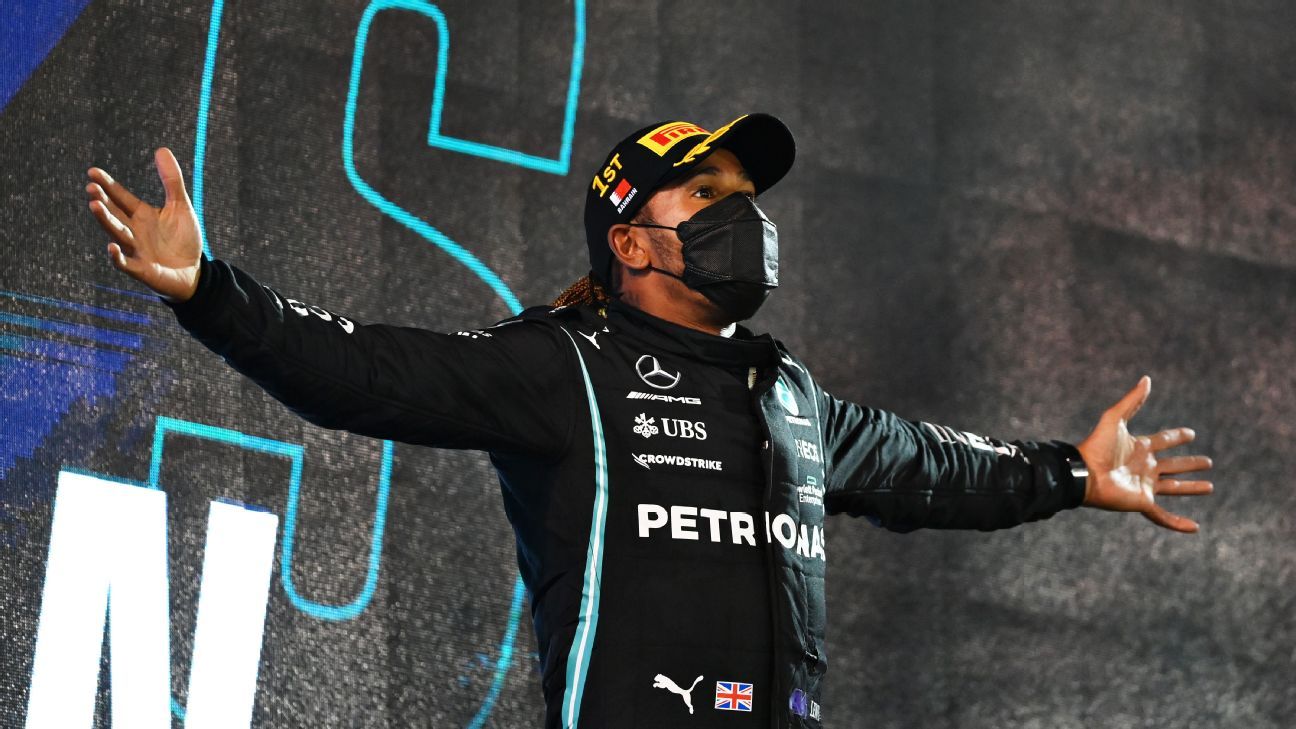For all the millions of dollars and labour hours invested by Mercedes and Red Bull over the winter, the two cars that Lewis Hamilton and Max Verstappen raced on Sunday evening were split by just 0.7s after 300km of racing.
The close finish was the best result Formula One could have hoped for and teases the potential for the most exciting title battle in years.
What made the race so great was that it could have gone either way.
On pure performance, Red Bull had the edge, but Mercedes was close enough that a clever tyre strategy had the potential to turn the tables.
Hamilton drove one of the best races of his career. Verstappen, it’s fair to say, did not. But the two hours of entertainment that resulted was absolute box office.
Lewis beats Max
The fact the two cars were closely matched on performance meant the drivers and strategists could make the difference, and that was key to the entertainment value.
Verstappen was slight hamstrung by a misbehaving differential on his car that took the edge off the car’s performance in the first sector. It wasn’t the defining factor in the race, but it was enough for Hamilton to smell blood in the early part of the race and keep the pressure on.
Maintaining a small gap to Verstappen early on was key to victory as it allowed Mercedes’ pit wall to deploy a very aggressive tyre strategy.
The world champions pitted as early as possible for their two planned tyre changes, gaining track position from Verstappen at the first pit stop and putting the onus on the Red Bull driver to win the race with an overtaking move.
The plan worked, with the Red Bull driver emerging from his first pit stop behind Hamilton, albeit with tyres that were five laps younger.
In response to Mercedes decision to pit Hamilton early on lap 13, Red Bull had changed tack and the main focus was on building a tyre life advantage into Verstappen’s strategy.
Hamilton reset the cycle on lap 28, just before Verstappen was close enough to attempt an undercut of his own and regain track position, again forcing Red Bull to focus on maximising the current stint and emerging at the end of the race with the freshest possible tyres to attack. Mercedes, however, had another counter punch in mind.
The idea was to pit Hamilton’s teammate, Valtteri Bottas, who was running third behind Verstappen at the time and had the potential to force Red Bull into an earlier pit stop.
When Bottas pitted on lap 30, he had the potential to undercut Verstappen in the same way Hamilton had at the start of the race.
Red bull would have had enough time to respond and keep Verstappen ahead, but in doing so, it would have sacrificed the tyre advantage it was hoping to build for the end of the race.
Bottas was not impressed by Mercedes’ tactics, feeling like a pawn in a chess match between Hamilton and Verstappen, but had he stayed out, it’s unlikely he would have found a way past Verstappen anyway.
This way, Mercedes would either end up triggering an early stop from Verstappen to defend from Bottas, solidifying Hamilton’s lead, or, if Verstappen stayed out, having two cars ahead of the Red Bull.
The strategy ultimately fell flat due to a sticking right-front wheel nut at Bottas’ pit stop, ruling the Finn out of contention for a top two finish.
The sticking wheel nut was great news for Red Bull as it allowed Verstappen to stick to his original plan, extend his second stint to lap 39 and emerge from his final stop 8.8s behind Hamilton but with tyres that were 11 laps fresher.
That tyre advantage offered up a performance advantage that saw Hamilton’s lead cut to less than a second in the space of 11 laps.
“I was thinking, ‘Jeez, there’s just no way we’re going to be able to pull this off with these tyres dropping off,’ particularly in the last 10, 15 laps,” Hamilton said.
“But it’s not my first rodeo — I was trying to find the right balance: not taking too much out of the tyres but not doing the same times as him because, when he comes out, he’s going to be much, much faster on fresh tyres, so I was trying to eke-out that gap to around 10 seconds.
“I think he came out of the pits and was around eight seconds behind, or something like that, and he just started eating up into that gap, very, very fast. And then it stopped for a moment. I think I was able to pick up the pace but then the tyres were starting to drop again.
“When the team told me that he’s going to catch us with ten laps to go, I knew we were sitting ducks at that point – but I just tried to remain positive and try to be just as inch-perfect as I possibly could be.”
It all built to a fantastic finish in which the onus was back on the drivers to make the most of their situation: Hamilton had track position but Verstappen had the faster car and fresher tyres.
Verstappen’s big chance came on lap 53 when he passed Hamilton around the outside of Turn 4, but ran wide on the exit.
Race Control told Red Bull that Verstappen would have to give the position back, and the message was relayed to Verstappen by Turn 8, with the Red Bull driver giving the position back to Hamilton on the exit of Turn 10.
A series of small mistakes, including a slide through Turn 13, appeared to damage Verstappen’s tyre further and he didn’t quite have the grip to mount another challenge in the remaining laps.
“I got into Turn 13 and I had a big oversteer and from there onwards I just didn’t have the tyres any more to attack,” Verstappen said. “Of course my tyres were, I think, ten or eleven laps younger but with these cars, that advantage goes away very quickly once you get within 1.5s and like I said before, with the wind in the direction it was, it was not helping.
“With these cars, I think the last three years, it is very important to have track position and we gave that up today.”
After the race Verstappen questioned the decision to give the place back to Hamilton when he could have accelerated away, incurred what would probably have been a five-second penalty and try to compensate for it by building a five-second gap on track.
But Red Bull team boss Christian Horner was not convinced it would have worked out.
“I think it’s very difficult, we had an instruction from the race director to give the place back immediately,” Horner said. “Max was very sporting and did that. It was frustrating and Lewis had just enough to retain his position to the end of the race.
“There’s no guarantee that we could have got the five seconds if that had been the penalty. He did the right thing.”
Victory went to Hamilton and Mercedes, but Red Bull will still leave Bahrain with their heads held high.
Over the course of the weekend, Verstappen was the faster driver, but Mercedes and Hamilton raced a better race.
“If somebody would have told me that this is going to be the result on Sunday, I would have probably not believed it,” Mercedes team boss Toto Wolff said after the race.
“Still to give you 100% honesty we are still lacking pace in qualifying and today I think we were competitive. We are definitely competitive.
“The strategy made all the difference. We took a bold move at the beginning [by pitting early], gained track position. And then at the end, the racing gods were on our side.”
Vettel still nowhere
After a miserable final season at Ferrari in 2020, it seemed as though things could only get better for Sebastian Vettel in 2021.
At his new home at Aston Martin there was hope he would find a competitive team and a more supportive environment in which he could flourish and rediscover the potential that took him to four world titles with Red Bull between 2010 and 2013.
But on the evidence of his first weekend, things may have got worse this year.
Teammate Lance Stroll showed the Aston Martin was just about capable of finishing in the top ten, yet the only points Vettel secured in Bahrain were on his superlicence.
He was sent to the back of the grid for ignoring yellow flags in qualifying, incurring three penalty points, and then picked up another two points for taking Esteban Ocon out towards the end of the race. Both incidents were not what you would expect from a four-time world champion.
The yellow flags in qualifying also prevented him from setting a lap time quick enough to make it out of the first session of qualifying, and his compromised grid position meant he attempted a one-stop strategy in the race that was doomed to fail.
It is only one race of 23, but in a year in which Vettel was hoping to rebuild his reputation, things couldn’t have got off to a worse start.
Norris shines
The consensus coming into this year has been that 2021 is a key year for Lando Norris alongside new teammate Daniel Ricciardo. While Norris impressed alongside Carlos Sainz in his first two years at F1, it was still an unknown benchmark. In Ricciardo, Norris is going up against a multiple grand prix winner a driver considered to have world championship pedigree.
On the basis of the first weekend, Norris looks more than up to the task of matching the Australian. He was just out-qualified by Ricciardo on Saturday and the two of them wheel-to-wheel in the opening corners of the race. When the Safety Car came out on, Norris was marginally ahead and kept the position.
From there he never looked back and fourth position was a just reward for a brilliant performance. Norris had a nice battle with Charles Leclerc at mid-distance and showed brilliant race craft to get ahead.
Ricciardo was in good spirits about his first race, admitting he still has work to do to extract the maximum from his new car.
“I think the weekend as a whole, pretty satisfied,” he told Sky Sports. “The race itself I struggled for pace. I don’t think it was a strong race by any means but plenty to work on and learn from.
“Those first few laps actually once we got restarted, I think my pace was more comparable to Lando and Charles but then as the race went on I felt like I was falling back and back and just struggled to push on the tyre, I felt like I would just cook it.
“There’s still some finessing I can do with the car. Learn probably also the sweet spot of the car in set-up.
“I was in Turn 2, I really tried to avoid Mick as he was so close. Got too much on power and the tyres didn’t take it. My fault, very disappointed.”
Mazepin’s awful F1 debut
Nikita Mazepin probably won’t remember his first Formula One weekend too fondly. The controversial Russian driver had several spins throughout the weekend – including two in qualifying on Saturday evening — and the final one was the worst of the bunch.
Mazepin’s unforced error came just three corners into the race, with the Russian getting on the throttle too early and losing control of his car out of Turn 3.
Mazepin said he had got too close to teammate Mick Schumacher and had to take evasive action.
“I really tried to avoid Mick as he was so close,” Mazepin said after the race. “Got too much on power and the tyres didn’t take it.
“My fault, very disappointed.”
He added: “Very simple, I made a mistake. “The tyres were cold and I got on the kerb, took too much throttle and spun. Totally my mistake. Very sorry for the team because they deserve to do much better than that. Very angry with myself… yeah, sorry for the team.”
Mazepin told ESPN earlier this year he wanted fans to judge him based on his on-track performances rather than off-track controversies and this was an unfortunate way to follow up that kind of statement.
Mazepin’s teammate Mick Schumacher had a spin of his own but managed to keep the car out of the wall, and finished his first F1 race 16th out of 16 classified drivers.


